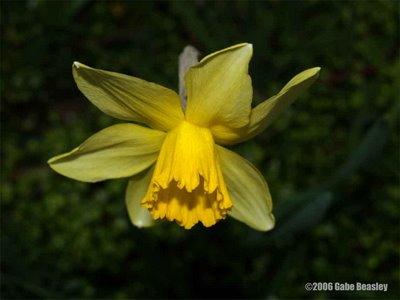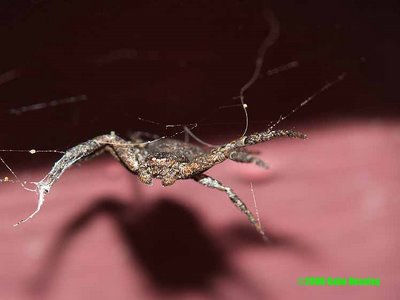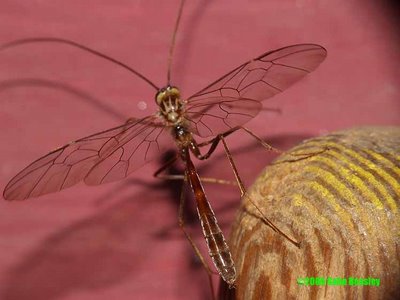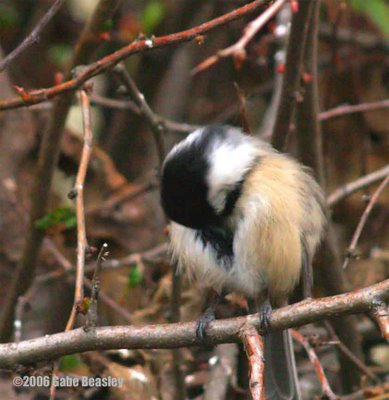 I have many pictures of this lone flower which popped up in my back yard. I have no idea what kind of flower it is yet. I just take pictures of them. This flower popped out of nowhere. There are lots of plants of all interesting kinds growing in my yard. I'm going to let it grow until it gets dry so I can get some good insect and wildlife shots. Most of the local areas I've got my old pictures of bees and other stuff--sadly are gone now. They are developing like crazy here.
I have many pictures of this lone flower which popped up in my back yard. I have no idea what kind of flower it is yet. I just take pictures of them. This flower popped out of nowhere. There are lots of plants of all interesting kinds growing in my yard. I'm going to let it grow until it gets dry so I can get some good insect and wildlife shots. Most of the local areas I've got my old pictures of bees and other stuff--sadly are gone now. They are developing like crazy here.
And here is one weird crab spider. The "blackish flat kind". They do not seem to change color like there white or yellow cosines. I have yet to identify this species.

This flower is less then 3mm across. I'm so exited and glad--my new macro setup could shoot the hairs on a flea's back if I had one. I don't mean to brag. It's not like I have a $700 macro lens yet. I am just very glad I have been able to get this setup finally and figure out macro shots with it. I was doing some really nice shots with old video camera lenses and a $100 simple digital compact camera when I first started out doing digital stuff before I even had a computer let alone a website. I began to build my own lenses back in my 35mm days before my website for my film camera. Then I learned a great deal that way and was able to move up the technology latter. When you can finally afford it, it really pays to get a good digital SLR and also know how to build your own lens attachments. At least get a basic understanding of optics is a good idea. I would recommend to anyone starting in photography to start from the bottom like I did. I was broke when I got started and found an old film SLR in a local thrift store. With that I began my new life taking pictures. An old all-manual film SLR. Learn how to use a manual mechanical Film SLR and work your way into new stuff. Learn how to process B&W film and learn film (because digital emulates it) and learn light as well as optics. Get comfortable there before you jump into digital and digital SLRs. You should learn how every control on your camera works and what each control does. If you leave your SLR on manual most of the time you may as well have bought a point and shoot-- you are just showing off with a big camera! I'm very glad I did things that way. There is no way you can take shots like this without knowing the basics of how optics and cameras work. Auto just does not cut it now matter how advanced things seem to get. Learning manual controls and how they work in both new digital cameras and old ones is a good idea. The settings are all still the same. CLICK ON THESE PICTURES for a better view.
 This is the same spider--it's only about 2cm long from right to left. Your looking at it face on now as it has fallen carelessly to escape me and got tangled up in some old spider webbing! Crab spiders do not spin webs. They do use silk to make egg cases, and sometimes manage food, but they are solitary hunters that can bring down insects much larger and more dangerous then they are. A classic shot I did a few months back under "all pictures" you can see one holding a honey bee seemingly effortlessly from a flower. The bee must have weighed at least twice as much as the spider. I made sure this potentially unlucky tangled spider was released before I left it.
This is the same spider--it's only about 2cm long from right to left. Your looking at it face on now as it has fallen carelessly to escape me and got tangled up in some old spider webbing! Crab spiders do not spin webs. They do use silk to make egg cases, and sometimes manage food, but they are solitary hunters that can bring down insects much larger and more dangerous then they are. A classic shot I did a few months back under "all pictures" you can see one holding a honey bee seemingly effortlessly from a flower. The bee must have weighed at least twice as much as the spider. I made sure this potentially unlucky tangled spider was released before I left it.However normally I do not interfere in nature and try to minimize my interference as much as possible. I do not agree with killing spiders or insects these days for collections. High resolution digital cameras at a relatively low cost can provide very good shots for identification. The last thing we want to do is add to the number of creatures we kill in this world. I tried and even was tutored by a real entomologist at the University of Guam. I made my own collections, and insect collections-- once I saw the potential of digital photography I found that most surveys done on insects and spiders are useless killings. One shot can provide positive ID these days if it is done by someone who knows what they are doing. Some species are threatened and there are even endangered species of spiders that are illegal to harm.
 This is some kind of gal wasp I think. I am not sure the exact species.
This is some kind of gal wasp I think. I am not sure the exact species.  I have become more interested in birds since I have been able to take pictures of them with long lenses. These finches? (I think) are an incredible 3-4in' tall. They are almost as small as some humming birds. They are very tiny but my new digital SLR gives me views I thought very difficult or impossible before.
I have become more interested in birds since I have been able to take pictures of them with long lenses. These finches? (I think) are an incredible 3-4in' tall. They are almost as small as some humming birds. They are very tiny but my new digital SLR gives me views I thought very difficult or impossible before. And here this same bird cleaning itself. I spent nearly an hour watching them again. Catching a lot more pictures I may post later. These are low light shots with a long zoom lens.
And here this same bird cleaning itself. I spent nearly an hour watching them again. Catching a lot more pictures I may post later. These are low light shots with a long zoom lens. And another word comes to mind--is that a "starling"? Words come into my mind but I'm not sure. I do not have a bird field guide and need to get one. One thing that I just can't get over is that they may look large here, but as I say-they are very small birds and interesting to watch. They have some social actions and calls--especially when birds of pray come around. Not that common to see. I've already got one shot. It's rare but Bald Eagles sometimes fly right over my roof. I might someday be able to get a good shot of one. I practice with anything--small aircraft and clouds--so that I know what to do to set my camera for catching a large bird flying above. I am learning more and more about using digital SLRs (DSLR) every day but I still carry my macro kit for my DX7630 and in some cases it could be an advantage due to it's small size when the bugs get more active.
And another word comes to mind--is that a "starling"? Words come into my mind but I'm not sure. I do not have a bird field guide and need to get one. One thing that I just can't get over is that they may look large here, but as I say-they are very small birds and interesting to watch. They have some social actions and calls--especially when birds of pray come around. Not that common to see. I've already got one shot. It's rare but Bald Eagles sometimes fly right over my roof. I might someday be able to get a good shot of one. I practice with anything--small aircraft and clouds--so that I know what to do to set my camera for catching a large bird flying above. I am learning more and more about using digital SLRs (DSLR) every day but I still carry my macro kit for my DX7630 and in some cases it could be an advantage due to it's small size when the bugs get more active.
1 comment:
The yellow flower is a daffodil. You're so lucky to have them growing in your yard. It's too cold a climate where we live, so the only daffodils we see are the ones in florist shops and grocery stores. By the way, nice bird shots.
Post a Comment